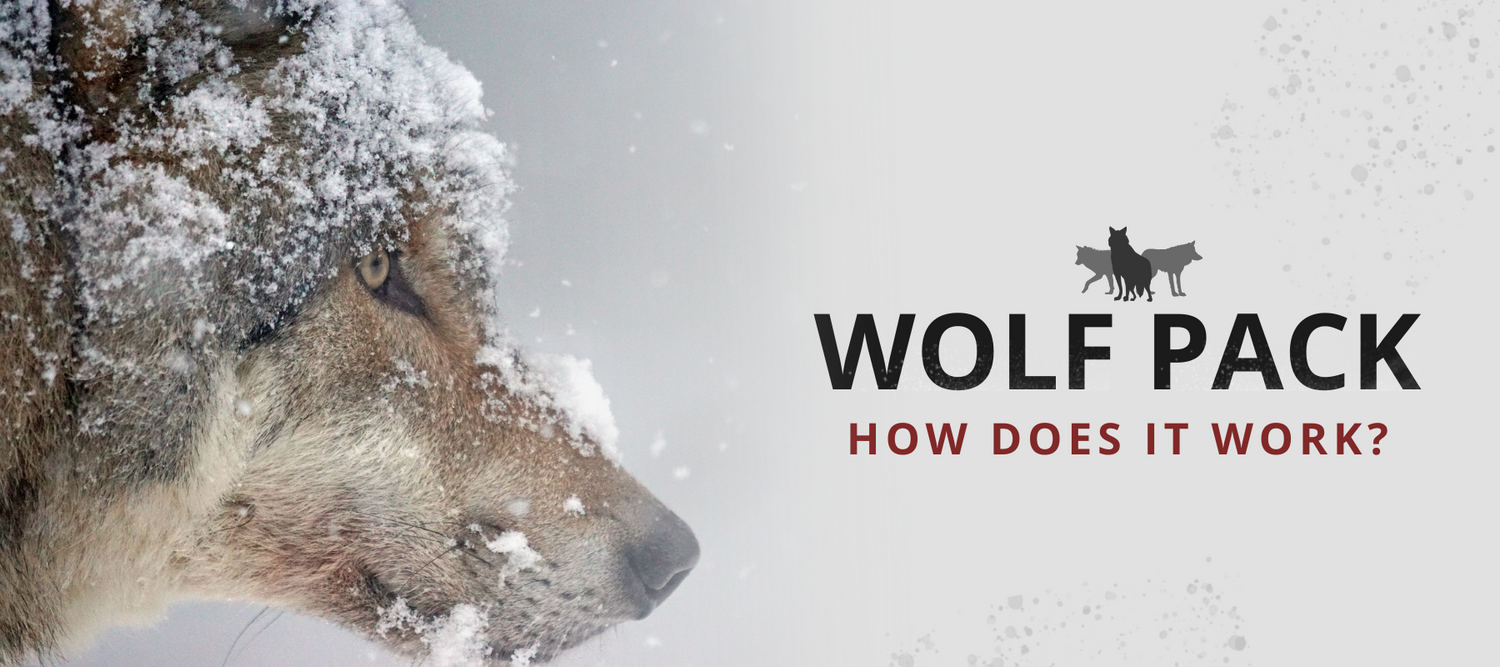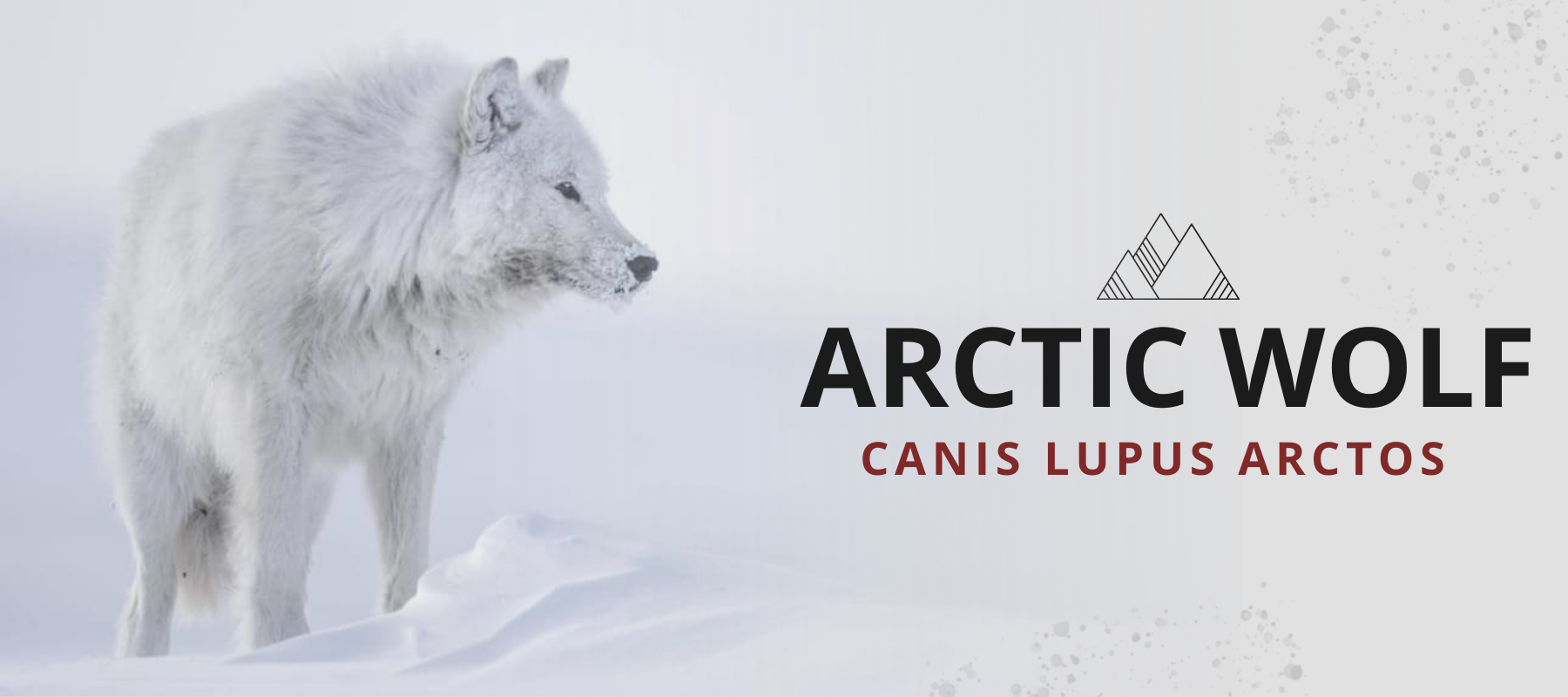
THE LONE WOLF MYTH
An overall thinking suggests that there are independent lone wolves living by their own. Although there are conflicts between pack members that can lead a member to leave the group, a wolf rarely lives alone by choice. Without its fellow wolves, the lone wolf become a prey and is not able to survive in the wild environment.
This is why the meaning of lone wolf only hold his charm in common beliefs. The pack exists for the survival of the group, when they work together, they became smarter and stronger to hunt. Moreover, the pack ensures the preservation of wolf population and the learning of the cubs. Far from this image of the lone wolf, we will therefore focus on the dominance hierarchy and how wolves live together.
WHAT IS A WOLF PACK?
In the animal kingdom, the term "pack" refers to a group of canids, between 2 and 15 individuals, generally close relatives.
The pack is characterized by a precise hierarchical order in which one we distinguish a leader, intermediate elements and subordinates.
In wolves’ group, the leader of the pack is always a male called “alpha”. Its female is, by definition, turn into an alpha female. The two subjects of higher rank and of the opposite sex are the only ones to mate once a year.
HOW BIG ARE WOLF PACKS?
Mostly, the group of canids varies between 2 and 15 individuals. The size of the pack depends on the existing prey, with larger prey, wolf packs also become larger.
WHAT ARE THE RANKS IN A WOLF PACK?
Whether we speak about Mexican gray wolves, red wolves, Mexican wolves or other wolf subspecies, a similar social structure can be seen in pack of wolves. Based on wolf behavior studies, a wolf pack is made up of individuals with different roles within the community. In hierarchical order:
What is an alpha wolf in a wolf pack?
The pack is made up of a dominant couple in the role of group leader. The male is called Alpha wolf. They make all the decisions necessary for the well-being of their entire pack and are the only ones to reproduce.
Alphas are by definition the highest individuals in the hierarchy of a group. Their instinctive missions are to organize meals, to take the initiative in hunting departures and to guide the pack during the hunt.
They play a very important role in the initiation and organization of the pack's movements and ensure the defense of the territory by scent markings and howling.
Unsurprisingly, the dominant male behaves like a leader and benefits of many privileges. Besides being the only male to be able to mate, he is also the first to have access to food in order to eat as much as he wants.
Alpha males can be recognized by their postures, straight ears, fixed gaze, and straight tail.
What is a beta wolf in a wolf pack?
These wolves are placed in the second row, behind the alpha couple. Their instinctual mission is to protect the alpha couple. We can define them as bodyguards. They are dedicated to deflecting many dangers to protect the precious pack leaders. They are the biggest, most intrepid wolves in the family and they are very vigorous, enforcing the laws of the pack led by the alpha couple.
Beta wolves delimit their territory by depositing odours secreted by glands located under their toes and they will also leave claw marks in strategic places. In case of potential danger, they also have the role of pathfinder.
The line of their back, although sustained, is less clear-cut than that of an alpha. The howling of the beta wolf is less severe than that of an alpha, although it remains guttural, it sounds 3 to 4 times longer than that of an alpha and thus reinforces and prolongs the calls of the pack.
It is the individual who will approach you first to determine the danger and test you. However, when close to the alpha couple, he will lower his head and tail to show his bondage. He remains, nevertheless, the most apt to replace the alpha male if he dies or loses his place, especially during the breeding season.
What is a gamma wolf?
The Gamma wolf is placed in the third row, behind the beta. Their instinctive mission is to control the territory and create the illusion of numbers with a precise positioning technique that gives the impression that they are more numerous. As a result, the pack appears larger. It's a strategy for defending and protecting the territory.
Regarding howling, gamma wolves emit a symphony of sounds, accompanied by barking, howling and growling. Gamma wolves are very suspicious, nervous and sensitive to the approach of danger, which they are constantly on the lookout for. They stand guard, making rounds around the territory to warn the beta and alpha quickly of any new element, in order to keep the pack safe. The beta and alpha rely on them to give an alert in order to maintain order within the clan.
What is an omega wolf in a wolf pack?
An Omega wolf is essential to the survival of a pack, even if it is placed at the bottom of the pack.
The wolf's instinctive mission is to break up hostilities to lower tensions within a pack. He is the scapegoat who receives all the social aggression from the rest of the pack.
He stands in the middle of the quarrels to try to calm the other wolves, soothe their stress, make them move from aggression to serenity. In doing so, he restores balance. He is a pillar for the good understanding of the pack.
We recognize him by his posture, flattened fur, ears lowered, he shaves the ground, his tail folded between his legs.

HOW ROLES ARE ESTABLISHES WITHIN THE WOLF PACK ?
Once again, we are far from the myth of the fight to the death between male wild wolves to determine the leader. In truth, there are two most recurring cases:
First possibility, the pack is born from the development of a family and therefore starts from a single male-female couple. The first members of the pack will be the pups born from their mating: they will receive hunting and trapping instruction from their parents (focusing on play-based learning), fighting and socialization.
The male and female are their guides, their teachers, and no one questions their authority: they are the alpha male and female, and no one will challenge their status.
When the two "alpha" subjects start mating again the following year, the new offspring will be confronted with the undisputed authority of the chief and the leader, but also with the hierarchical superiority of their elder siblings. Thus, a threefold hierarchical order will have been created spontaneously and naturally: chiefs, mid-level and low-level wolves, i.e. the youngest and most inexperienced subjects.
Second possibility: before having a litter, the initial couple meets another group of wolves (either a second couple or a small family unit with wolf pups) and decides to join it. Social animals tend to unite because they instinctively know that a group has a better chance of survival than a couple.
These chances are based on the fact that social animals have the ability to communicate with each other and to develop precise hunting plans, cooperating and coordinating their action to disperse their prey and maximize the result with a minimum energy.
When two couples hunt together for the first time, one of the two males may be clearly more skilled and experienced than the other, and the latter may readily accept the role of alpha male. If both feel that they are equal, then, confrontation becomes almost inevitable. But beware, as stated before, they will never fight to the death. Such a fight could have serious consequences:
- The winner could also be seriously injured and may not survive.
- The genetic heritage represented by the loser would surely be lost forever, which would be useless for the survival of the wolf species.
Before they can really bite each other, the two opponents follow a pattern of attitudes, mimics and growling which are often sufficient to reveal a submissive wolf and a pack leader. A high tail, a straight head with ears pointing forward are therefore signals of strength.

HOW WOLF PACK WORKS?
The pack is not a fixed and immutable structure: For example, when the number of subjects becomes too high compared to the food resources in the environment, some members can be rejected. But don't think that this persecution applies to subjects of lower rank (omega), as this almost never happens.
In most cases, exclusion concerns young females (two or three years old on average), which enter into heat period during the breeding season, which can lead to conflict with the alpha female: if the confrontation occurs and the young female wolf decides to leave the pack, she will probably be followed by a young who has not yet had the opportunity to find a mate.
Thus, a new couple is created, which will give birth to a new pack. This new pack will go hunting on a new territory, to prevent conflicts with their initial pack.
REALITY OF WOLF PACK HIERARCHY
For a long time, we thought that there was a real hierarchy within wolf packs, in which each member has a specific role and the whole group was led by an alpha male and female.
In reality, this dominance theory needs to be qualified. As seen previously, the hierarchy is naturally routed. Dave Mech, a scientist and biologist who have put forward rigid hierarchies relied on studies carried out over a period of time that is too short to be conclusive and often with captive wolves and not wild ones.
As a result, many false information has been circulated over the years and continue to spread. However, scientists have reconsidered their position based on a group of wolves in captivity that is not representative of the behavior of this social animal in a wild environment.
In fact, a wolf pack (wolf canis lupus in the broad sense) is not led by the strongest and most combative wolf, but rather by a breeding pair. The other members of the pack are their offspring, and therefore younger individuals. It is actually more correct to speak of "breeding male" and "breeding female" rather than "alpha male" and "alpha female".
Besides, the notions of beta and omega are no longer used. There is no real hierarchy within a wolf pack. It is a family with the objective to protect each other. This is particularly important when confronting another pack.
The parents teach to the youngest predation, howling and how to protect other wolves. They will participate more actively in the life of the pack only when they have grown up, for example by hunting (caribou, bison, rodents and other prey animals) or looking after the youngest when the breeding pair is away. They also participate in the learning of the youngest of the next gestation.
When they reach two years old, the young wolves can leave the pack and look for a partner to start their own family. Some may also choose to stay longer. They will then help the parents to feed and educate the cubs.
HOW DO WOLF PACKS TRAVEL?
Members of the pack usually move one after the other in a straight line through their territory, but they may scatter to find prey more easily.
Finally, the order of movement depends on the reason for the movement (hunting or other) and the external conditions. For example, in case of heavy snow, wolves travel in single file so that the first one traces the path to save energy.

TO SUM UP...
In the end, the wolf is much closer to Man than we might think. Regardless of species (arctic wolf, Ethiopian wolf, Timber wolf, Maned wolf…), his family organization focuses on a deep attachment to the members of his pack as we do with our family.
It is undoubtedly because we share common values with the wolf that we find many accessories and jewelry bearing his effigy, such as wolf bracelets. If you are interesting to learn more about others facts on wolf, we recommend you to read our blog post to discover how do wolves hunt?




